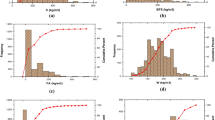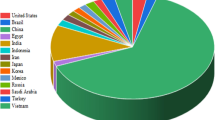Abstract
This study aimed to examine the effects of replacing a portion of cement with GGBS and including a bacillus subtilis bacterial solution at the most effective GGBS usage levels. The development of M25 grade concrete involved the utilization of four different quantities of GGBS (namely, 5%, 10%, 15%, and 20%) as substitutes for cement. The bacterial solution was prepared using three different quantities of bacteria, specifically 103, 105, and 107 cells/ml. This bacterial solution was used to replace 10% of the mixing water. The mechanical properties of concrete produced alone with GGBS and with the addition of a bacterial solution were examined. Furthermore, the water absorption of the samples was also assessed under both conditions. The test results indicate that a bacterial concentration of 105cells/ml in 10% GGBS leads to the highest mechanical strength. When the proportion of GGBS in concrete exceeded 10%, the strength began to decrease. The presence of bacteria in the concrete led to a decrease in its water absorption capacity. Consequently, regression analysis revealed a higher R2 values for bacterial GGBS concrete in comparison to GGBS concrete. R2 value for GGBS sample and bacterial solution were 0.771 and 0.818.










Similar content being viewed by others
Data availability
No datasets were generated or analysed during the current study.
References
Gandhimathi, A., Suji, D., & Elayarajah, B. (2015). Bacterial concrete: Development of concrete to increase the compressive and split-tensile strength using bacillus sphaericus. International Journal of Applied Engineering Research, 10(3), 7125–7132.
Hosseini Balam, N., Mostofinejad, D., & Eftekhar, M. (2017). Effects of bacterial remediation on compressive strength, water absorption, and chloride permeability of lightweight aggregate concrete. Construction and Building Materials. https://doi.org/10.1016/j.conbuildmat.2017.04.003.
Jongvivatsakul, P., Janprasit, K., Nuaklong, P., Pungrasmi, W., & Likitlersuang, S. (2019). Investigation of the crack healing performance in mortar using microbially induced calcium carbonate precipitation (MICP) method. Construction and Building Materials, 212, 737–744. https://doi.org/10.1016/j.conbuildmat.2019.04.035.
Karimi, N., & Mostofinejad, D. (2020). Bacillus subtilis bacteria used in fiber reinforced concrete and their effects on concrete penetrability. Construction and Building Materials, 230, 117051. https://doi.org/10.1016/j.conbuildmat.2019.117051.
Kaveh, A., & Zakian, P. (2012). Performance based optimal seismic design of RC shear walls incorporating soil-structure interaction using CSS algorithm. INTERNATIONAL JOURNAL OF OPTIMIZATION IN CIVIL ENGINEERING Int J Optim Civil Eng, 2(3), 383–405. https://www.researchgate.net/publication/272182495.
Kaveh, A., & Zakian, P. (2014). Seismic design optimisation of RC moment frames and dual shear wall-frame structures VIA CSS algorithm. Asian Journal of Civil Engineering.
Kaveh, A., Izadifard, R. A., & Mottaghi, L. (2020). Optimal design of planar RC frames considering CO2 emissions using ECBO, EVPS and PSO metaheuristic algorithms. Journal of Building Engineering. https://doi.org/10.1016/j.jobe.2019.101014.
Kumar Parashar, A., Gupta, A., Gupta, N., & Verma, P. (2022). Regression analysis for assessing the impact of Megaterium bacterial solution on Bagasse Ash concrete. Advances and Applications in Mathematical Sciences, 21(7), 4173–4182.
Mahima, S., Bahurudeen, A., Santhanam, M., & Jayachandran, K. (2017). Service Life Prediction of Bagasse ash blended concrete in Marine Splash Zone. Materials Today: Proceedings, 4(9), 9664–9672. https://doi.org/10.1016/j.matpr.2017.06.244.
Nagar, P. A., Gupta, N., Kishore, K., & Parashar, A. K. (2020). Coupled effect of B. Sphaericus bacteria and calcined clay mineral on OPC concrete. Materials Today: Proceedings, xxxx. https://doi.org/10.1016/j.matpr.2020.08.029.
Nagarajan, V., Prabhu, T. K., Shankar, M. G., & Jagadesh, P. (2017). A study on the strength of the bacterial concrete embedded with Bacillus Megaterium. International Research Journal of Engineering and Technology (IRJET), 4(12), 1784–1788.
Nain, N., Surabhi, R., Yathish, N. V., Krishnamurthy, V., Deepa, T., & Tharannum, S. (2019). Enhancement in strength parameters of concrete by application of Bacillus bacteria. Construction and Building Materials, 202, 904–908. https://doi.org/10.1016/j.conbuildmat.2019.01.059.
Parashar, A. K. (2016). (n.d.). Effects of the concentration of various bacillus family bacteria on the strength and durability properties of concrete: A Review.
Parashar, A. K., & Gupta, A. (2020). Investigation of the effect of bagasse ash, hooked steel fibers and glass fibers on the mechanical properties of concrete. Materials Today: Proceedings, xxxx. https://doi.org/10.1016/j.matpr.2020.10.711.
Parashar, A. K., & Gupta, A. (2021). Effects of the concentration of various bacillus family bacteria on the strength and durability properties of concrete: A Review. IOP Conference Series: Materials Science and Engineering, 1116(1), 012162. https://doi.org/10.1088/1757-899x/1116/1/012162.
Parashar, A. K., Gupta, N., Kishore, K., & Nagar, P. A. (2020). An experimental investigation on mechanical properties of calcined clay concrete embedded with bacillus subtilis. Materials Today: Proceedings, October, 0–6. https://doi.org/10.1016/j.matpr.2020.08.031.
Rautray, S. S., Mohanty, B. N., & Das, M. R. (2019). Performance of self-compacting geopolymer concrete using Bacillus Licheniformis. Materials Today: Proceedings. https://doi.org/10.1016/j.matpr.2020.02.587.
Siddique, R., Nanda, V., Kunal, Kadri, E. H., Iqbal Khan, M., Singh, M., & Rajor, A. (2016). Influence of bacteria on compressive strength and permeation properties of concrete made with cement baghouse filter dust. Construction and Building Materials. https://doi.org/10.1016/j.conbuildmat.2015.12.112.
Singla, N., Sharma, S. K., & Rattan, J. S. (2016). An Experimental Investigation on Properties of High Strength Bacterial Concrete (Bacillus Subtilis). 381–385.
Sri Bhavana, R., Raju, P., P., & Asadi, S. S. (2017). Experimental study on bacterial concrete with partial replacement of cement by fly ash. International Journal of Civil Engineering and Technology, 8(4), 201–209.
Tziviloglou, E., Wiktor, V., Jonkers, H. M., & Schlangen, E. (2016). Bacteria-based self-healing concrete to increase liquid tightness of cracks. Construction and Building Materials, 122, 118–125. https://doi.org/10.1016/j.conbuildmat.2016.06.080.
Vijay, K., Murmu, M., & Deo, S. V. (2017). Bacteria based self healing concrete– A review. Construction and Building Materials, 152, 1008–1014. https://doi.org/10.1016/j.conbuildmat.2017.07.040.
Author information
Authors and Affiliations
Contributions
Hanumant Sharan Singh: Conceptualization, Methodology, Writing- Reviewing and Editing. Gaurav Shukla: Data curation, Writing- Original draft preparation.
Corresponding author
Ethics declarations
Competing interests
The authors declare no competing interests.
Additional information
Publisher’s Note
Springer Nature remains neutral with regard to jurisdictional claims in published maps and institutional affiliations.
Rights and permissions
Springer Nature or its licensor (e.g. a society or other partner) holds exclusive rights to this article under a publishing agreement with the author(s) or other rightsholder(s); author self-archiving of the accepted manuscript version of this article is solely governed by the terms of such publishing agreement and applicable law.
About this article
Cite this article
Singh, H.S., Shukla, G. Regression analysis of properties of GGBS based bacillus subtilis bacterial concrete. Asian J Civ Eng (2024). https://doi.org/10.1007/s42107-024-01059-z
Received:
Accepted:
Published:
DOI: https://doi.org/10.1007/s42107-024-01059-z




